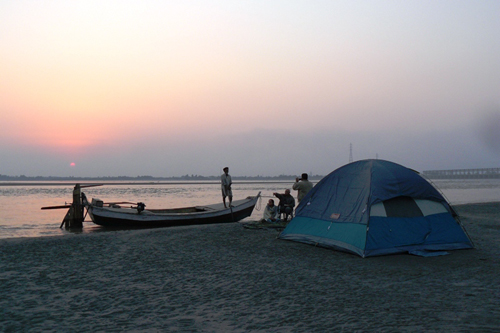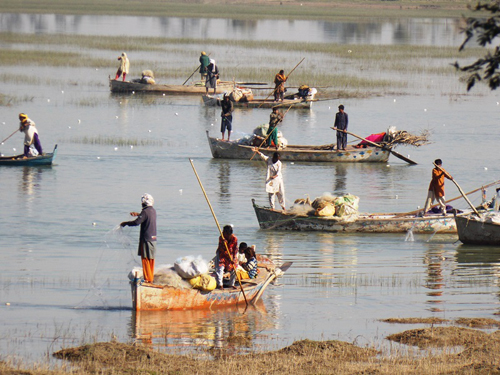Like other fishermen along the Taunsa Barrage in Pakistan’s Punjab province, Safdar Hussain considered the Indus river dolphin dangerous and would kill it whenever it got caught in its net. Not any more though, he says happily, crediting an innovative programme to increase awareness that has not only given the endangered mammal a new lease of life but also increased his income.
The training and awareness imparted by the ecotourism project launched by the NGO Sustainable Tourism Foundation Pakistan (STFP) has changed attitudes completely, he said.
“It was like a big but useless and dangerous fish for us before but now we know that it is a human friendly animal,” said Hussain. “We also know that if we protect the dolphin, it will help increase our income.”
A large number of tourists from across Pakistan have started coming to Taunsa Barrage in Punjab’s Muzaffargarh district, giving a fillip to the dolphin and also to the local economy, with fishermen such as Hussain as well as local craftsperson and others benefiting.
“My monthly income has jumped from Rs.3,000 (approximately $30) to Rs.5,000 ($50) in just a few months due to the boat safaris. Tourists love to see and touch the dolphin,” he said.

The STFP project started in October last year and ends this July, a big step forward in Pakistan’s struggles to conserve the Indus river dolphin by promoting ecotourism and creating awareness among people, especially fishermen, about the role of the human-friendly mammal in protecting biodiversity.
Around 1,400 dolphins, locally called Bulhan, live along the 1,500-kilometre stretch of the Indus river in Pakistan and are listed as “endangered species” by the International Union for Conservation of Nature.
The aim of the project is to protect and conserve dolphins from threats such as accidental killing through net entanglement, unsustainable fishing practices, entrapment in irrigation canals and deliberate killing for its oil that is used as fish bait and in some traditional medicines and pollution, said Aftab Rana, STFP president.
Equally, the project also aims at boosting livelihoods of fishermen by promoting ecotourism in the region.
Community involvement
The NGO is training about 800 fishermen families live along the Taunsa barrage.
“The fishermen are being helped upgrade their boats, fishing skills, fishnets and relevant equipment as part of the scheme to save the dolphins,” said Rana.
He added that the community was also being helped to develop local artefacts to attract tourists and generate income from sources other than fishing.
“The income from ecotourism will be an incentive and reward for the poor fishermen community and this will encourage them to be friendlier with the dolphin and play an active role in conserving one of the most unique species living in the world today,” Rana said.
“The project is working to minimise threats (to the dolphin) through local
community involvement and empowerment,” he said, adding that two teams of friends of the Indus river dolphin have been established to manage rescue operations in the area and train some 20 local fishermen in dolphin rescue skills.

A vocational training centre for women is also being opened up in the area to train the women in local products like embroidery and display them for the tourists, said Javed Iqbal, president of the Indus Welfare Foundation, an NGO that works for the rights of fishing communities.
He said a committee comprising activists from the community had also been set up to promote social enterprises and local songs and dances. “We are working on a complete package that includes monthly income increase of the fishermen, conserving the dolphins and increasing its population as well,” he said.
The government should award public waters’ contracts to local fishermen instead of wealthy contractors to alleviate poverty and sense of deprivation in the community, he suggested, adding that Pakistan is the only country where provincial governments auction public waters to contractors to generate revenue.
According to Iqbal, “If the government puts an end to the contract system, it will automatically treble income of the fishermen.”
More about dolphins
The Indus river dolphin is also known as blind dolphin as it is functionally blind due to its unique adaptation to living in a turbid river environment, said Z.B. Mirza, an expert on wildlife of Pakistan and one of the founding members of WWF-Pakistan.
Historically, he said, dolphins were found in large numbers right from the Indus estuary up into the foothills of the Himalayas but now the numbers in the Indus had dwindled to just around 1,400, which is not a healthy number for the survival of any wild animal species.
The population and diversity of wildlife, including not just dolphins but also crocodiles, otters and many fish species, was shrinking due to numerous
human interventions. “The Indus river dolphin is also facing serious threats of extinction; therefore it is our collective responsibility to take effective measures to conserve it,” he said.
WWF Living Planet Report 2014 has urged Pakistan to protect biodiversity
and reduce its ecological footprint as the global populations of fish, birds, mammals, amphibians and reptiles have declined by 52% in the 40-year period measured in the current edition. It also says the decline of biodiversity in the wider Asia-Pacific region ranks only behind Latin America in the same period.
![<p>An Indus river dolphin spotted in Dhunda [image courtesy: WWF-India]</p>](https://dialogue.earth/content/uploads/2018/05/Indus-River-Dolphin-in-Dhunda_WWF-India.jpg)